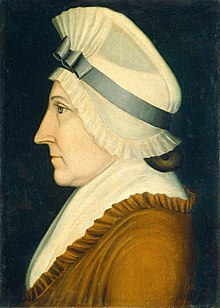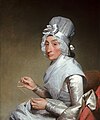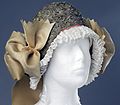
A mobcap (or mob cap or mob-cap) is a round, gathered or pleated cloth (usually linen) bonnet consisting of a caul to cover the hair, a frilled or ruffled brim, and (often) a ribbon band, worn by married women in the 18th and early 19th centuries, when it was called a "bonnet". These caps were always gathered to a flat, often curved, brim. The caul had a flat bottom and curved top. The bottom was typically gathered to fit the back neck with a drawstring, while the curved sides and top were tightly gathered and stitched to the brim, which typically had some curves, too. Originally an informal style, the bonnet became a high-fashion item as part of the adoption of simple "country" clothing in the later 18th century. It was an indoor fashion, and was worn under a hat for outdoor wear.
Etymology
The origin of the term mobcap is a compound of mob "dishabille, casually dressed" + cap. It may be modeled on Dutch mop (muts) "woman's cap".
From at least 1730 to at least 1750, a single mob cap could be referred to as "a suit of mobs" or 'a suit of mobbs', while the plural mob caps could be described as 'suits of mobs' or 'suits of mobbs'.
Variations
The one piece, ruffled, gathered circle mobcap often seen worn with historical costumes is a simplified, modern interpretation, rather than a copy of a period cap.
By the Victorian period, mobcaps lingered as the head covering of servants and nurses, and small mobcaps, not covering the hair, remained part of these uniforms into the early 20th century.
Modern versions of mobcaps are still worn in the pharmaceutical industry, in clean-rooms, and in other sectors where the hair has to be contained. These mobcaps are usually a simple circle shape with an elastic band and may be made of disposable materials such as spun-bound polypropylene so they are like a shower cap. They can also be made of nylon netting.
Gallery
-
 1778
1778
-
 A portrait by English landscape and portrait painter, Joseph Wright of Derby, of an unidentified woman sporting a large mobcap
A portrait by English landscape and portrait painter, Joseph Wright of Derby, of an unidentified woman sporting a large mobcap
-
 1789
1789
-
 Marie Antoinette c. 1792
Marie Antoinette c. 1792
-
 1793
1793
-
 James Jacques Joseph Tissot's Man, Woman, and Map, which features a mobcap
James Jacques Joseph Tissot's Man, Woman, and Map, which features a mobcap
-
 A portrait of Mrs. Herman Henry Schroeder (the former Suzannah Schwartz) by Charles Peale Polk, which was completed in about 1794
A portrait of Mrs. Herman Henry Schroeder (the former Suzannah Schwartz) by Charles Peale Polk, which was completed in about 1794
-
 1796
1796
-
 Mobcap with gold brocade, gold lace and sequins worn by wealthy ladies in Żywiec, Poland
Mobcap with gold brocade, gold lace and sequins worn by wealthy ladies in Żywiec, Poland
References
- Merriam-Webster, Merriam-Webster's Unabridged Dictionary, Merriam-Webster.
- 'The Real Moll Flanders: 18th Century Criminal Trials and Punishment': Part 2, the case of Hester Norton. 10 May 1735.
City of York – The Examination of Hester Norton, singlewoman taken the 10th day of May 1735. Being charged with stealing a silver tumbler, four half crowns, a pair of silver studs, two pairs of little silver buttons, a suit of mobs, five pounds and half penny, two gold rings, a black silk hood. Confesseth she stole the said Tumbler and two rings from George Gray on Saturday night last but denys she stole any besides.
- 'The Real Moll Flanders: 18th Century Criminal Trials and Punishment': Part 2, the case of Hester Norton. 10 May 1735.
City of York - The information of George Gray of Stillingfleet in the County of York, yeoman, taken upon oath the 10th day of May 1735. This informant saith and deposeth that on Saturday night last he was in his own right possessed of a silver tumbler, four half crowns which were in the cup, a pair of silver studs and two pair of little silver buttons, a suit of mobbs, five pounds and half penny, two gold rings, a black silk hood which have been since stolen by some person or persons unknown
- Archdeacon Wills 1737/8 #74 Ballaugh, of Mrs Mary Corlett als Parr of Ballakeig, Ballaugh, wife of John Corlett. 8 February 1730.
to my Aunt Mary Christian a prenella gown, four suits of mobs with muslin borders and a firlet of malt at Michaelmass. Item, to my sister in law Elizabeth Corlet als Parr my best suit of clothes, a prenella gown and a petticoat, and the rest of my headclothes 8th day of February 1730
- Will of Elizabeth Rugge, Widow of Inner Temple, City of London – The National Archives. 3 November 1749.
the third day of November in the year of our Lord Seventeen hundred and forty nine eight strong good Shifts 6 good aprons as many Neckhandkerchiefs 6 good Suits of Mobbs and all my Common Wearing Linnen and all my Cloaths except my black Sack my light grey Lutestring and my Stitched under Pettycoats
External links
 Media related to Mob caps at Wikimedia Commons
Media related to Mob caps at Wikimedia Commons
| Historical clothing | ||
|---|---|---|
| Clothing generally not worn today, except in historical settings | ||
| Body-length |  | |
| Tops | ||
| Trousers | ||
| Skirts | ||
| Dresses | ||
| Outerwear |
| |
| Underwear | ||
| Headwear |
| |
| Footwear | ||
| Accessories | ||